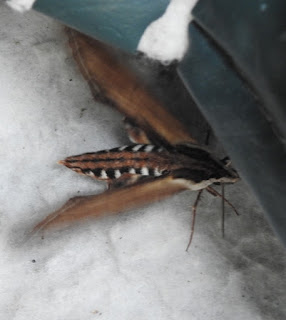** Louise Nichols
and Anne Marsch visited Ann’s Acres near Cape Jourimain on Friday. They noted
a LEAST SANDPIPER [Bécasseau minuscule] that appeared dark and water-soaked.
Louise got a photo of it beside a normal-looking Least Sandpiper. We wonder if
this bird had got into an oily substance that gave rise to its unusual
appearance. They also noticed a BLACK SWALLOWTAIL [Papillon de céleri] butterfly
in that area, and a group of four EASTERN KINGBIRDS [Tyran tritri], probably a
family unit. A NORTHERN HARRIER [Busard Saint-Martin] cruised the nearby marsh
and suddenly dropped down and stayed down.
Louise also found a
LAUREL SPHINX [Sphinx du laurier] moth at her home in Sackville; it seems late
for this species to be flying. She also spotted a colourful WHITE-MARKED TUSSOCK
MOTH caterpillar [Chenille à houppes blanches] on apple tree foliage. This
caterpillar usually has a red head but for some reason, this one lacks that
feature.
** NORTHERN GANNETS
[Fou de Bassan] are appearing more regularly off coastal areas at the moment,
with the adults showing their “fluorescent” white plumage. Aldo Dorio got a
photo of one in flight offshore at Tabusintac on Saturday. I noted several while
crossing the Confederation Bridge on Saturday. Aldo also got a GREAT SPANGLED
FRITILLARY [Argynne cybèle] butterfly nectaring on the ever-popular JOE-PYE-WEED
[Eupatoire maculée].
** Brian Stone has several RUBY-THROATED
HUMMINGBIRDS [Colibri à gorge rubis] coming to his feeder. On Saturday, he photographed one that he suspects
is a young of the year.
** WILD
PARSNIP [Panais] has been in the news a lot, after a young person was badly
blistered after being in contact with the sap of this plant that can make skin
sensitive to sun exposure. The Wild Parsnip is a very common roadside plant in
this area. Especially on Saturday after hearing the news on it,
I noted hundreds of
plants at roadside. I’m not aware of these problems from local media but assume
that the same potential is here. Some photos of the plant are attached. It is
getting mature at the moment and going to seed. This was the source of our
domestic parsnip and has the strong smell of parsnip, when the leaves are
crushed, but it’s obviously not a good idea to do that without proper gloves
that can be disposed of.
Another plant
appearing roadside and elsewhere at the moment is CHICORY [Chicorée]. Its blue
blooms are striking. Apparently, the roots of this plant have been used as a
coffee substitute in the past.
nelson@nb.sympatico.ca
Nelson Poirier
Nature Moncton
Nelson Poirier
Nature Moncton
BLACK SWALLOWTAIL. LOUISE NICHOLS. AUGUST 7, 2015
CHICORY.AUG 8, 2015.NELSON POIRIER (3)
CHICORY.AUG 8, 2015.NELSON POIRIER (3)
EASTERN KINGBIRD. LOUISE NICHOLS. AUGUST 7, 2015
GREAT SPANGLED FRITILLARY BUTTERFLY.AUG 8, 2015.ALDO DORIO
LAUREL SPHINX MOTH (a). LOUISE NICHOLS. AUGUST 8, 2015
LAUREL SPHINX MOTH (a). LOUISE NICHOLS. AUGUST 8, 2015
LEAST SANDPIPER (POSSIBLY OILED). LOUISE NICHOLS. AUGUST 7, 2015
LEAST SANDPIPER. LOUISE NICHOLS. AUGUST 7, 2015
LEAST SANDPIPERS. LOUISE NICHOLS. AUGUST 7, 2015
NORTHERN GANNET.AUG 8, 2015.ALDO DORIO
RUBY-THROATED HUMMINGBIRD (SUSPECT YOUNG-OF-THE-YEAR) 01. AUG. 08, 2015. BRIAN STONE
WHITE-MARKED TUSSOCK MOTH CATERPILLAR. LOUISE NICHOLS. AUGUST 8, 2015
WILD PARSNIP.AUG 8, 2015.NELSON POIRIER. (2)
WILD PARSNIP.AUG 8, 2015.NELSON POIRIER. (2)
WILD PARSNIP.AUG 8, 2015.NELSON POIRIER. (2)















